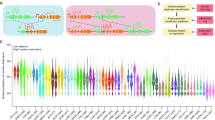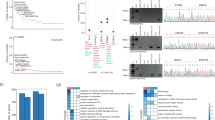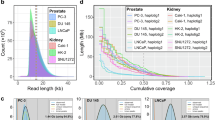Abstract
Cytogenetic aberrations have been reported in 45,000 human neoplasms. Structural balanced rearrangements are associated with distinct tumor subtypes with remarkable specificity and have been essential for identifying genes involved in tumorigenesis1,2. All balanced rearrangements that have been characterized molecularly act by deregulating a gene in one of the breakpoints or by creating a fusion gene3,4,5,6. Because most recurrent aberrations and rearranged genes have been found in hematological disorders, whereas numerous genomic imbalances have been identified in solid tumors7,8, it has become generally accepted that there are pathogenetic differences between these neoplasms. We here show that in every tumor type, the numbers of recurrent balanced chromosome abnormalities, fusion genes and genes rearranged as a consequence of balanced aberrations are simply a function of the number of cases with an abnormal karyotype. Hence, there may not be any fundamental tissue-specific differences in the genetic mechanisms by which neoplasia is initiated.
This is a preview of subscription content, access via your institution
Access options
Subscribe to this journal
Receive 12 print issues and online access
$259.00 per year
only $21.58 per issue
Buy this article
- Purchase on SpringerLink
- Instant access to full article PDF
Prices may be subject to local taxes which are calculated during checkout

Similar content being viewed by others
References
Heim, S. & Mitelman, F. Cancer Cytogenetics 2nd edn. (Wiley-Liss, New York, 1995).
Mitelman, F., Mertens, F. & Johansson, B. A breakpoint map of recurrent chromosomal rearrangements in human neoplasia. Nat. Genet. 15, 417–474 (1997).
Rabbitts, T.H. Chromosomal translocations in human cancer. Nature 372, 143–149 (1994).
Look, A.T. Oncogenic transcription factors in human acute leukemias. Science 278, 1059–1064 (1997).
Rowley, J.D. Chromosomal translocations: dangerous liaisons revisited. Nat. Rev. Cancer 1, 245–250 (2001).
Helman, L.J. & Meltzer, P. Mechanisms of sarcoma development. Nat. Rev. Cancer 3, 685–694 (2003).
Mertens, F., Johansson, B., Höglund, M. & Mitelman, F. Chromosomal imbalance maps of malignant solid tumors: a cytogenetic survey of 3185 neoplasms. Cancer Res. 57, 2765–2780 (1997).
Albertson, D.G., Collins, C., McCormick, F. & Gray, J.W. Chromosome aberrations in solid tumors. Nat. Genet. 34, 369–376 (2003).
Eguchi, M. et al. Fusion of ETV6 to neurotrophin-3 receptor TRKC in acute myeloid leukemia with t(12;15)(p13;q25). Blood 93, 1355–1363 (1999).
Knezevich, S.R., McFadden, D.E., Tao, W., Lim, J.F. & Sorensen, P.H.B. A novel ETV6-NTRK3 gene fusion in congenital fibrosarcoma. Nat. Genet. 18, 184–187 (1998).
Rubin, B.P. et al. Congenital mesoblastic nephroma t(12;15) is associated with ETV6-NTRK3 gene fusion. Cytogenetic and molecular relationship to congenital (infantile) fibrosarcoma. Am. J. Pathol. 153, 1451–1458 (1998).
Tognon, C. et al. Expression of the ETV6-NTRK3 gene fusion as a primary event in human secretory breast carcinoma. Cancer Cell 2, 367–376 (2002).
Nowell, P.C. The clonal evolution of tumor cell populations. Science 194, 23–28 (1976).
Hanahan, D. & Weinberg R.A. The hallmarks of cancer. Cell 100, 57–70 (2000).
Loeb, L.A., Loeb, K.R. & Anderson, J.P. Multiple mutations and cancer. Proc. Natl. Acad. Sci. USA 100, 776–781 (2003).
Lengauer, C., Kinzler, K.W. & Vogelstein, B. Genetic instabilities in human cancers. Nature 396, 643–649 (1998).
Nowak, M.A. et al. The role of chromosomal instability in tumor initiation. Proc. Natl. Acad. Sci. USA 99, 16226–16231 (2002).
Sieber, O.M., Heinimann, K. & Tomlinson, I.P.M. Genomic instability – the engine of tumorigenesis? Nat. Rev. Cancer 3, 701–708 (2003).
Knudson, A.G. Two genetic hits (more or less) to cancer. Nat. Rev. Cancer 1, 157–170 (2001).
Lengauer, C. How do tumors make ends? Proc. Natl. Acad. Sci. USA 98, 12331–12333 (2001).
Heim, S., Mandahl, N. & Mitelman, F. Genetic convergence and divergence in tumor progression. Cancer Res. 48, 5911–5916 (1988).
Gorunova, L. et al. Cytogenetic analysis of pancreatic carcinomas: intratumor heterogeneity and nonrandom pattern of chromosome aberrations. Genes Chromosomes Cancer 23, 81–99 (1998).
Romana, S.P. et al. The t(12;21) of acute lymphoblastic leukemia results in a tel-AML1 gene fusion. Blood 85, 3662–3670 (1995).
Golub, T.R. et al. Fusion of the TEL gene on 12p13 to the AML1 gene on 21q22 in acute lymphoblastic leukemia. Proc. Natl. Acad. Sci. USA 92, 4917–4921 (1995).
Druker, B.J. Inhibition of the Bcr-Abl tyrosine kinase as a therapeutic strategy for CML. Oncogene 21, 8541–8546 (2002).
Rabbitts, T.H. & Stocks, M.R. Chromosomal translocation products engender new intracellular therapeutic technologies. Nat. Med. 9, 383–386 (2003).
Acknowledgements
This work was supported by the Swedish Cancer Society and the Swedish Children's Cancer Foundation.
Author information
Authors and Affiliations
Corresponding author
Ethics declarations
Competing interests
The authors declare no competing financial interests.
Rights and permissions
About this article
Cite this article
Mitelman, F., Johansson, B. & Mertens, F. Fusion genes and rearranged genes as a linear function of chromosome aberrations in cancer. Nat Genet 36, 331–334 (2004). https://doi.org/10.1038/ng1335
Received:
Accepted:
Published:
Issue date:
DOI: https://doi.org/10.1038/ng1335
This article is cited by
-
MTAP-ANRIL gene fusion promotes melanoma epithelial-mesenchymal transition-like process by activating the JNK and p38 signaling pathways
Scientific Reports (2023)
-
Human transcription factor and protein kinase gene fusions in human cancer
Scientific Reports (2020)
-
Kasumi leukemia cell lines: characterization of tumor genomes with ethnic origin and scales of genomic alterations
Human Cell (2020)
-
NCLcomparator: systematically post-screening non-co-linear transcripts (circular, trans-spliced, or fusion RNAs) identified from various detectors
BMC Bioinformatics (2019)
-
Novel identification of STAT1 as a crucial mediator of ETV6-NTRK3-induced tumorigenesis
Oncogene (2018)



